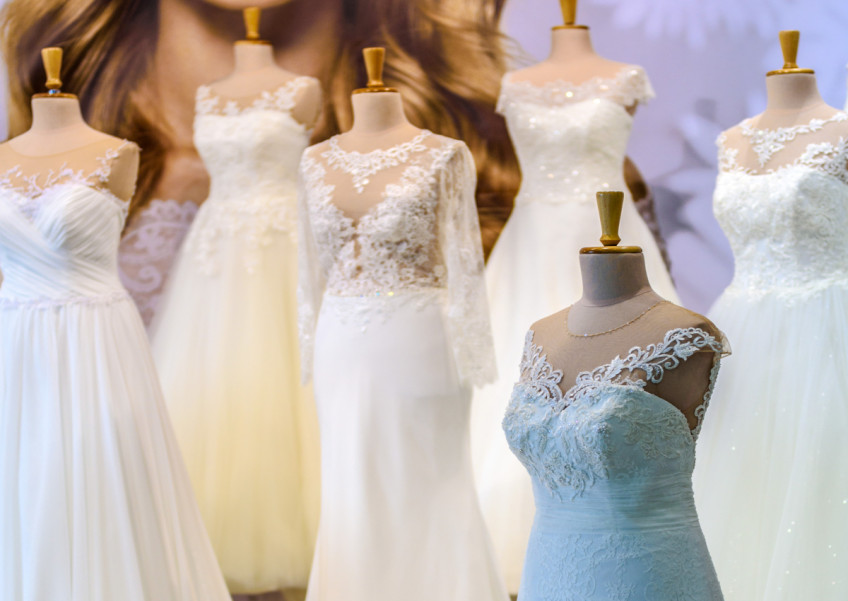Wedding politics: Actually, change so many outfits for what ah?

If you've ever attended a Chinese wedding, then you've probably noticed the bride disappear for a hot second only to re-emerge in a completely different outfit.
According to Jas Alyssa Lin, the Head Stylist at Grace Atelier Weddings, Singaporean Chinese brides typically have four outfit changes throughout their wedding - two traditional and two modern ones. She breaks it down for us.
Outfit #1: The bride leaves her home with her hair in a bun and traditional bridal gown as a symbol of good luck, once she reaches the church, she changes.
Outfit #2: A qun kua, which emerged during the Ming Dynasty, is worn for the tea ceremony to pay homage to the bride's Chinese heritage.
Outfit #3: The bride changes into the main wedding gown that she'll use to walk down the aisle.
Outfit #4: As the final outfit, the bride wears a coloured or evening gown, usually a slimmer fitting one, to mingle and have fun with her guests during dinner.
[[nid:461451]]
In the past, brides probably didn't have much say in their outfit changes, but over the years the tradition has become more flexible.
"Brides that opt for one gown take a more relaxed approach to the wedding," says Jas, adding that they usually "have their weddings at restaurants or unconventional places, wear more alternative bridal gowns and host the event as more of a celebration than a traditional wedding."
We spoke to two brides who recently had their weddings, and both of them have very different approaches when it came to their outfits. Beatrice L., 28, had five outfit changes in total-at the request of her mom.
"My mom requested multiple outfit changes throughout the day for reasons of tradition, which I agreed to," she elaborates.
"In total, I had five outfit changes. I wore older outfits though, not all of them were bought specially for the wedding."
And if you're a bride taking notes, here's what Beatrice did: "I wore my day wedding gown for the first march in, then a pantsuit combo with a detachable skirt for the second march in. After the second march in and champagne pouring, I removed the skirt and wore it as a glitzy pantsuit for the rest of the evening."
[[nid:446223]]
"I created the pantsuit for the purpose of wearing it [more than once] as it is [appropriate] for any occasion worth celebrating."
Meanwhile, Rachel C., 30, tied the knot recently with just one outfit for her big day.
"My wedding was a very intimate affair - just our parents, siblings, grandparents and a handful of childhood school mates."
"Neither my husband nor I really cared for a wedding, but we did it to please our elders and the deal was that it wouldn't be a big event," she shares.
"I wanted to keep things simple so I wore one cheongsam throughout the day-for the tea ceremony, exchange of vows and dinner."
BUT, WHAT DO THE GUESTS THINK?
It's the bride's big day and she's entitled to how she wants her wedding to be, outfit changes included. But we can't help but wonder-does it make any difference to the guest's experience?
"I don't even remember if the bride changed her dress," says Alicia G, trying to recall from a wedding she attended in 2013.
A more recent wedding attendee offered this: "The most recent one that I went to, the bride changed three times, but I don't remember what she wore."
"The only wedding outfit changes I remember were the ones at my best friends' weddings," she adds.
A poll of over 200 CLEO readers showed that the general sentiment is that outfit changes, while nice, doesn't make a difference to anyone else but the bride, with 65 per cent voting that it isn't necessary to change into multiple outfits.

One follower @poiuytrewer offers this: "It's not necessary to me, but if it makes you happy and you can afford it, then why not?"
While a follower on the other end of the spectrum had a more pragmatic view.
"No one will remember what you wore, so spend that time with your guests instead."
NOT JUST FOR THE 'GRAM
In the past, these outfit changes were a show of wealth, and also symbolised luck. Jas notes that in her experience, there are young brides who want to retain as much tradition as possible for their family, keeping the practice out of respect rather than obligation.
So really, it doesn't matter if the guests can't recall the outfit changes - at the end of the day, it all boils down to what the bride wants. Besides, when else will we get the opportunity to parade around in gorgeous gowns?
This article was first published in CLEO Singapore.